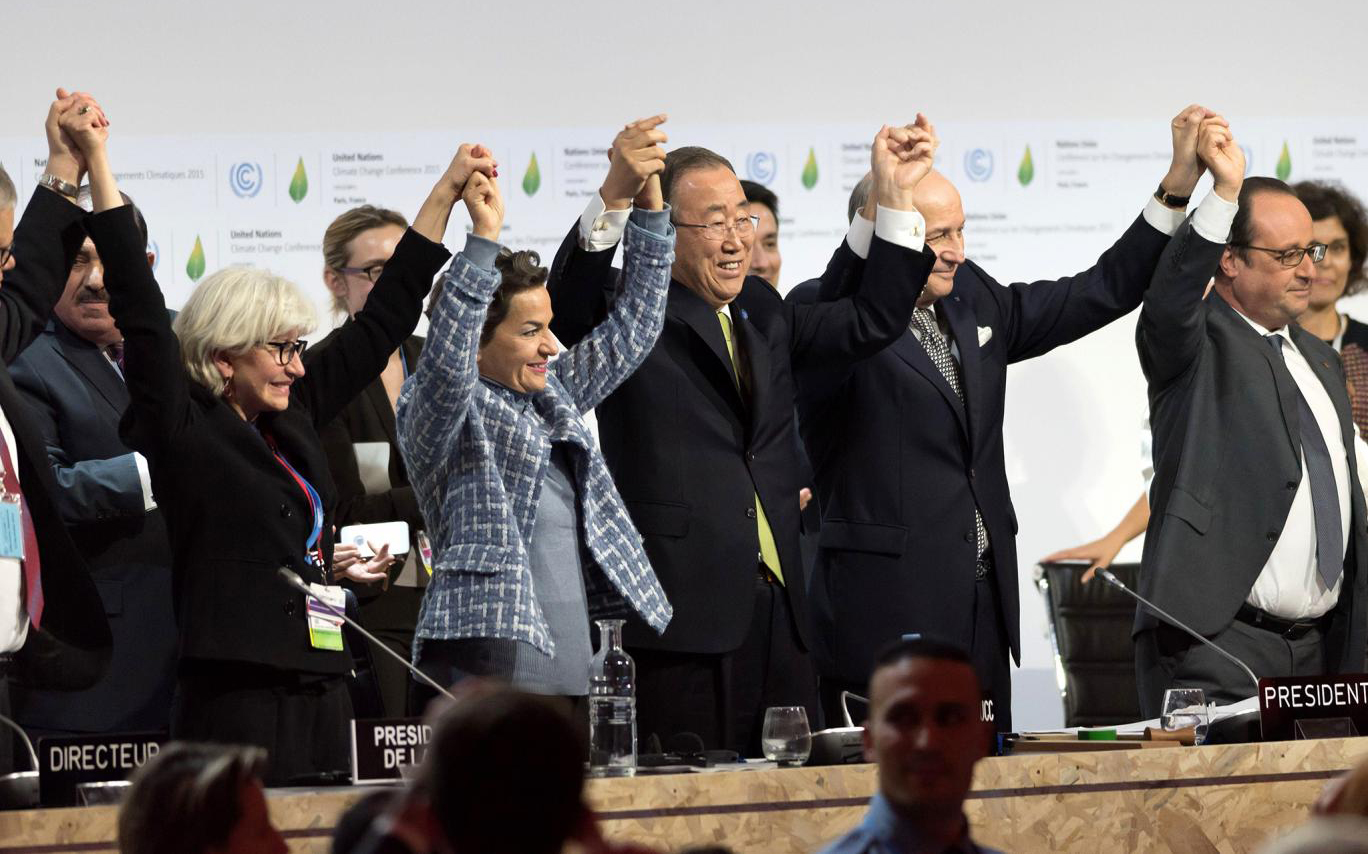COP 21 reaches historic agreement

World leaders celebrate the landmark agreement in Le Bourget, near Paris, on Dec. 12.
After nearly two weeks of intense negotiations, an agreement was finally reached at the 21st Conference of the Parties to the UN Framework Convention on Climate Change, also known as COP 21, in Paris on Dec. 12.
The pact, approved by all parties, aims to prevent the increase in average global temperature relative to pre-industrial levels from reaching 2 degrees. The signatories also pledged to take further actions to limit it to less than 1.5 degrees Celsius. All nations will try to set an upper ceiling for global greenhouse gas emissions as soon as possible and bring emissions down to net zero by the second half of this century.
Many have hailed the agreement as a victory with historic significance. For the first time in history, all the countries in the world are now committed to curbing carbon emissions and addressing climate change together. At the same time, however, hard work is still required to achieve its goals.
“The Paris Agreement has managed to bring all nations under one framework. This is an important step toward ‘entering into a logic of global decarbonization’ and therefore reaching a potential turning point,” said Christian Egenhofer, head of the Energy and Climate program at the Centre for European Policy Studies, adding that limiting carbon emissions is only the first step. Emissions will then reach an upper limit and decline, and fossil fuels will ultimately be phased out, he said.
The new framework aims to succeed where previous attempts had failed, Egenhofer said. In this process, the leadership of China, the European Union and the United States is indispensible, he said, adding that future progress will depend on their cooperation.
Georg Zachmann, a senior fellow on energy and climate change issues at the Bruegel institute, said a major breakthrough of the Paris Agreement is that it injects momentum into the fight against climate change, and a vital breakthrough is that all parties now have to contribute to mitigation.
However, he said the agreement still has many loose ends in terms of future decisions. One example is guidance on the Intended Nationally Determined Contributions. In addition, mitigating greenhouse gas emissions will remain costly.According to the agreement, all governments will need to raise their targets every five years. Without full support from the highest political levels in key countries, the whole agreement could still fall apart.
“All this depends on whether what was agreed upon will be implemented,” Egenhofer said. He said the main challenge for closing the emissions gap will be monitoring and ensuring that efforts can be enforced. It is very difficult to design methodologies as they combine technical complications with political issues.
The success of the agreement is largely contingent on the low-carbon sector’s ability attract sufficient investment to cover the high costs. While it is never easy to make a transition, it could be the best opportunity for profit since the Industrial Revolution, said David King, the UK foreign secretary’s special representative for climate change.
King said countries will need to design their climate policy for adaptation and increasing resilience. Markets must be expanded, while technologies need to be made more affordable, he said. Energy storage costs need to be lowered, and every country needs to construct a smart grid, which will require more intense international cooperation and research, King said.
Many economists suggested the most effective way to facilitate decarbonization is appropriately raising the cost of emissions, which will change the modes of consumption, investment and innovation. Current ways of doing so include carbon taxes and cap-and-trade schemes.
Egenhofer said that initially emissions trading would be more effective than taxes because it has a greater capacity to address economic and social implications. As technology costs come down over time, there might be a gradual convergence of carbon prices in countries to trigger low-carbon investment.Gradual convergence of electricity wholesale prices across the globe will be generated,too. Ultimately, this will facilitate some coordinated global carbon price and tax adjustment mechanism.
Jiang Hong is a reporter at the Chinese Social Sciences Today.

 PRINT
PRINT CLOSE
CLOSE